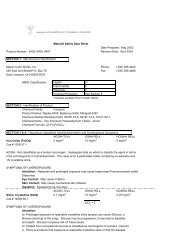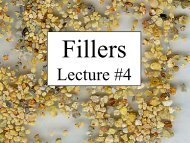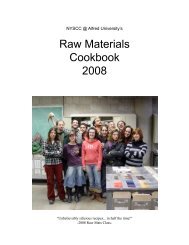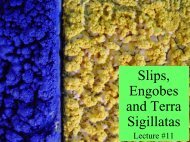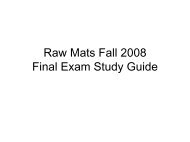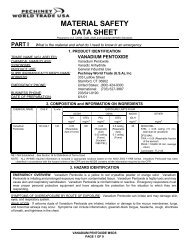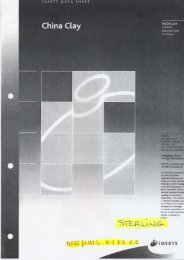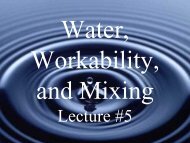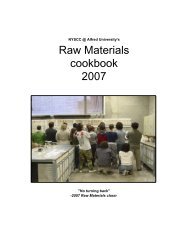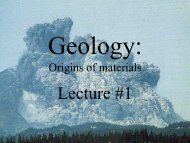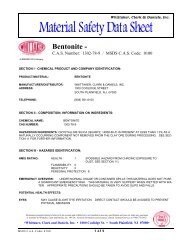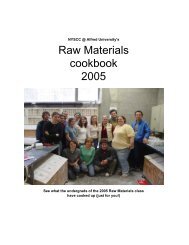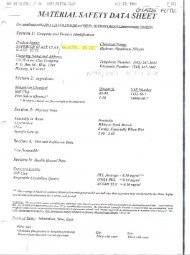Lecture #8 - Alfred's Clay Store
Lecture #8 - Alfred's Clay Store
Lecture #8 - Alfred's Clay Store
Create successful ePaper yourself
Turn your PDF publications into a flip-book with our unique Google optimized e-Paper software.
Firing<br />
<strong>Lecture</strong> <strong>#8</strong>
Firing<br />
• The final frontier<br />
– Work either makes it or breaks it<br />
• Even when forming and drying conditions<br />
are ideal, we can still loose work at this<br />
stage<br />
• Understanding the firing process can help<br />
us avoid costly mistakes<br />
• Before looking at firing, we will look at<br />
silica, as it is integral to the firing process
(alpha)<br />
(beta)<br />
(alpha)<br />
(beta)<br />
(no inversion)<br />
• A changes from one<br />
phase to another is<br />
called a silica<br />
conversion<br />
• Conversions are not<br />
reversible - they are<br />
one way streets<br />
• Within the same<br />
phase, a change from<br />
one form to another is<br />
called a silica<br />
inversion<br />
• Inversions are<br />
temperature dependent<br />
and are reversible
Quartz<br />
• Also known as free silica<br />
– “free” distinguishes this silica as not being chemically<br />
bound to other molecules (i.e. the silica in our Kaolinite<br />
crystal is not “free”; it’s bound with alumina)<br />
– If you had very small tweezers and steady hands, you<br />
could remove free silica from the clay<br />
• The major impurity found in clay<br />
– Up to 85% of a naturally occurring clay can be quartz<br />
• Quartz is also added to a body through flint or<br />
sand
Determining free silica in clays<br />
• Pure kaolin contains<br />
46% SiO 2 ; 39%<br />
Al 2 O 3<br />
– Silica above 46% is<br />
free silica<br />
• Secondary clays<br />
contain more free<br />
silica than primary<br />
clays<br />
– They have picked up<br />
silica in their travels<br />
% SiO 2 Al 2 O 3<br />
Grolleg 47.7 37.7<br />
OM4 53 30.8<br />
Red Art 54.3 16.4<br />
Hawthorn 55.1 39.11<br />
KT Stone 67.1 20.7
Alpha to Beta Quartz<br />
1064°F<br />
<br />
• 573 °C (1063 °F ) is known as the quartz inversion point<br />
• Quartz below 573 °C is always alpha quartz<br />
• Quartz above 573 °C is always beta quartz<br />
• Every time we pass the quartz inversion point, quartz<br />
inversion takes place
Effect of quartz inversion<br />
Alpha<br />
• As we approach the<br />
inversion temperature,<br />
the angle of bonding<br />
between silica<br />
tetrahedra changes<br />
– There is a straightening<br />
the the silica molecules<br />
Beta
Effect of quartz inversion<br />
573°C<br />
<br />
1%<br />
volume<br />
change<br />
• The straightening of the silica molecules<br />
accounts for approximately 1% volume<br />
expansion from alpha to beta quartz<br />
• This affects all quartz in the body
Alpha/Beta quartz expansion<br />
Inversion Point<br />
• Volume expands progressively quicker with<br />
temperature until it reaches the inversion point
Cristobalite inversion<br />
• Like quartz, cristobalite has two forms<br />
– Alpha and Beta<br />
• Inversion from Alpha to Beta occurs at 226 °C (439 °F)<br />
– Occurs more rapidly than quartz inversion<br />
– Like all inversions, this is reversible<br />
• Up to 3% volume change!<br />
• Happens at lower temps. when the body is rigid<br />
• Porous bodies handle cristobalite inversion better than<br />
dense bodies<br />
– Porous bodies can absorb shock better than tighter bodies
Alpha/Beta cristobalite expansion<br />
• Volume expansion increases suddenly at the<br />
inversion point
Poorly mixed<br />
Well mixed<br />
Silica<br />
<strong>Clay</strong><br />
Glass<br />
Cristobalite<br />
Cristobalite can form<br />
Cristobalite won’t form<br />
• Cristobalite formation is promoted by poor mixing<br />
– Clumps of silica in poorly mixed bodies can form cristobalite<br />
(because silica inside the pocket is isolated)<br />
– Isolated silica grains in a well mixed body form glass (each silica<br />
particle is surrounded/coated by clay)<br />
• We can avoid cristobalite by ensuring no two quartz<br />
particles touch<br />
– there is enough clay in any recipe to do this (assuming proper<br />
mixing takes place, i.e. Shar it!)
Cristobalite<br />
• Forms at higher temperatures<br />
– Free Quartz can convert to cristobalite above 1100<br />
°C (2012 °F ) cone 02<br />
• Temperature varies based on fluxes and time<br />
• Soaking above 1100 °C increases cristobalite formation<br />
• Conversion to cristobalite is irreversible as<br />
silica bonds of quartz are destroyed and<br />
reformed as cristobalite<br />
– Once cristobalite forms, it won’t go back to quartz
Glass<br />
• Glass forms when silica is melted and cooled<br />
quickly enough so that the silica tetrahedra cannot<br />
establish a pattern of structure<br />
– Crystalline matt glazes require slow cooling for this<br />
same reason<br />
– Glass is also referred to as non-crystalline silica<br />
• Glass sources in bodies include flint, feldspar, free<br />
silica and silica from clay minerals (i.e. kaolinite<br />
crystal)<br />
• Unlike quartz and cristobalite, silica glass does not<br />
go through inversions<br />
– No alpha or beta form<br />
– Stable throughout the firing process
• Glass Silica<br />
– AKA Amorphous<br />
silica; fused silica<br />
• Glass has a<br />
random structure<br />
• Cristobalite and<br />
Quartz are<br />
crystalline silica<br />
– Ordered,<br />
repeating<br />
structure<br />
Crystalline form<br />
Quartz<br />
Glassy form<br />
Glass
Glass expansion<br />
• Very low expansion
The Three<br />
Tenors<br />
(Like our three<br />
forms of silica,<br />
they’re related)
Minimizing the danger<br />
• Glass phase<br />
– No inversion…no problem<br />
• Quartz phase<br />
– Avoid adding excess free silica (I.e. silica-rich clays, flint<br />
and especially sand)<br />
– Fire slowly through inversion<br />
– Not as problematic as once thought<br />
• Cristobalite phase<br />
– Is not formed at low temperatures<br />
– Can be minimized at higher temps by proper mixing<br />
– Cool slowly through inversion<br />
– Avoid an excess of free silica / avoid soaking at high<br />
temperatures if possible
• Having examined silica’s phases, we will now take a<br />
chronological look at what happens during firing<br />
• Keep in mind that these overlap and that temperature can<br />
vary from one area of a piece to another during firing<br />
– Pyrometer readings can be off<br />
– Temperature at the pyrometer is different from temperature of<br />
the work<br />
– Temperature gradients throughout the work will vary during<br />
firing<br />
• Also, the extent to which these stages occur vary<br />
depending on mineralogy (Kaolinite is used as an ideal<br />
model, though it is not always the main clay mineral<br />
present in a given body)
Pore water removal<br />
• Up to 120 °C (248 °F)<br />
• The initial stages of firing can be seen as a<br />
continuation of the drying process<br />
(dehydration)<br />
• Drying is completed with the removal of the<br />
last traces of water on particle surfaces<br />
– Pore water is removed up to 120 °C<br />
• AKA “water smoking period”
• Explosions occur<br />
when pore water is<br />
removed too<br />
quickly<br />
– At 100 °C (212 °F)<br />
water turns to steam<br />
• Moisture condenses<br />
on a glassy surface<br />
placed above top<br />
spy hole until all<br />
water is removed<br />
– Hold below 100 °C<br />
until no more water<br />
condenses on glass
Organic decomposition<br />
• At approximately 200 °C (392 °F)<br />
• Organic matter, of mainly plant origins,<br />
breaks down<br />
– May cause a distinct odor (especially in<br />
secondary clays)<br />
• Slight expansion up to 1%<br />
– Not a problem during firing because body is still<br />
porous and somewhat resilient
Burning out<br />
• Carbon, Iron sulphide and Fluorine burn out<br />
– Combine with oxygen to form monoxide, dioxide and trioxide<br />
gases (CO, CO 2 , SO, SO 2 , SO 3 etc.)<br />
• Can lead to blistering and discoloration if fired too<br />
quickly<br />
• Starting point varies substantially with clay type<br />
– Carbon between 650-850 °C (1202-1652 °F)<br />
– Sulphur up to 1150 °C (2102 °F)<br />
• Remedies to bloating<br />
– Thoroughly mix the body<br />
– Slow down the firing – especially when once firing<br />
– Use a less dense body / add filler which allows gas to escape
Metakaolin formation<br />
• Occurs at about 550 °C (1022 °F)<br />
• Chemically bound water (crystal edge water +<br />
water of constitution) leaves the kaolinite crystal<br />
6(Al 2 O 3 • 2SiO 2 • 2H 2 O) 3(2Al 2 O 3 •4SiO 2 )+12H 2 O<br />
kaolinite metakaolinite water<br />
• Kaolin changes into metakaolin (very important)<br />
– Resulting in slight shrinkage<br />
– Very high porosity<br />
– 13.95% weight loss due to water<br />
– Plasticity is lost (a.k.a. “ceramic change”)
• Temperature range varies<br />
– Occurs after the formation<br />
of metakaolin and before<br />
glass formation begins<br />
• Particle are barely held<br />
together<br />
– Not fused but barely<br />
welded at very fine points<br />
of contact<br />
• Overall structure remains<br />
very open<br />
– Very little overall strength<br />
• This is what happens<br />
when we do a low bisque<br />
for glazing<br />
Sintering
Vitrification<br />
• Begins at around 800 °C (1472 °F)<br />
– Composition dependent<br />
– Particle size dependent<br />
• Soda and potash start to flux the quartz<br />
– Glass formation begins<br />
– Quartz grains convert to glass on outer<br />
edges and progress inwards as heat-work<br />
increases<br />
• Shrinkage increases<br />
– Pore volume decreases (voids collapse)<br />
– Density/strength increases
Spinel formation<br />
• Forms around 980 °C (1800 °F)<br />
• Metakaolin layers condense and re-crystallize,<br />
forming spinel crystals<br />
3(2Al 2 O 3 •4SiO 2 ) 3(2Al 2 O 3 •3SiO 2 )+ 3SiO 2<br />
metakaolinite spinel phase free silica<br />
• Silica is released from metakaolinite and<br />
contributes to glass formation
Mullite formation<br />
• Begins above 980 °C (1798 °F)<br />
– Really starts to grow past C. 6<br />
(1200 °C or 2194 °F)<br />
• Alumina from clay and feldspar<br />
dissolves into surrounding glass;<br />
When glass is saturated with<br />
alumina, extra alumina crystallizes<br />
into mullite<br />
• More free silica is also released; more glass is formed<br />
3(2Al 2 O 3 •3SiO 2 ) 2(3Al 2 O 3 •2SiO 2 )+ 5SiO 2<br />
spinel phase mullite free silica
Firing changes
Commercial porcelain after<br />
polishing and etching<br />
Pores<br />
Quartz<br />
Quartz<br />
Primary<br />
Mullite<br />
Secondary<br />
Mullite<br />
10 m
Mineralogical<br />
changes in a<br />
40% kaolinite<br />
30% quartz<br />
30% feldspar<br />
body
Cooling down<br />
• Top temperature down to 573 °C (1063 °F )<br />
– Contraction rate is gradual down to quartz inversion<br />
• At 573 °C<br />
– 1% contraction as beta quartz reverts back to alpha<br />
quartz<br />
• 573 °C - 500 °C (1063-932°F )<br />
– Glazes solidify<br />
• 226 °C (439 °F)<br />
– 3% contraction as cristobalite reverts from beta to alpha<br />
form<br />
– Paper burns at 451 °F
My bisque cycle<br />
Temp °F Rate/hr Hold<br />
0-190 100 Varies (overnight)<br />
190-950 150 -<br />
950-1200 100 -<br />
1200-1940 150 -<br />
1940-2079 100 -<br />
-Suitable for my body (heavily grogged;1/2” walls)<br />
This cycle could easily be sped up for thinner work
Bisque cycle<br />
2500<br />
Final<br />
Soaking<br />
2000<br />
2140 ºF<br />
Temp. (F)<br />
1500<br />
1000<br />
Ceramic<br />
change<br />
500<br />
Steam<br />
0<br />
0 1 2 3 4 5 6 7 8 9 10 11 12 13 14 15 16 17<br />
Time (hrs.)
Cooling cycle<br />
2500<br />
2000<br />
1500<br />
1000<br />
Quartz<br />
500<br />
0<br />
Cristobalite<br />
0 1 2 3 4 5 6 7 8 9 10 11 12 13 14 15
Complete cycle<br />
2500<br />
2000<br />
1500<br />
1000<br />
500<br />
0<br />
0 1 2 3 4 5 6 7 8 9 10 11 12 13 14 15 16 17 18 19 20 21 22 23 24 25 26 27 28 29 30 31 32
Re-firing schedule<br />
(I.e. Glaze schedule)<br />
• Differs from bisque firing because body is<br />
now less elastic (it is more dense)<br />
• Unlike bisque firing, cristobalite and quartz<br />
inversions need to be considered during<br />
heat-up<br />
– Especially true for large/thick work<br />
• Also generally no need for soaking at the<br />
start unless piece is damp from glazing
Glaze cycle<br />
2500<br />
2000<br />
1500<br />
1000<br />
Quartz<br />
500<br />
0<br />
Cristobalite<br />
0 1 2 3 4 5 6 7 8 9 10 11 12 13 14
Heat transfer during firing (in chronological order)<br />
1- Convection heat<br />
• Air is heated as it passes by the element; hot air rises, cool air sinks; air<br />
currents are created; air currents distribute heat<br />
– Not a very even source of heat (especially at lower temperatures)<br />
2- Conduction heat<br />
• Heat is transferred through direct contact<br />
– The main way to get even heating in a kiln<br />
– Outside wall of a piece heats the inside of the piece (or kiln shelf heats bottom<br />
of piece, which, in turn, heats middle and top of piece)<br />
– Requires time, especially with thicker work<br />
3- Radiant heat<br />
• Heat is transferred from hot to cold areas through radiation<br />
• Requires line of sight (like the rays of the sun)<br />
– something in the shadow of the heat source will not heat up as efficiently<br />
• Objects that heat up, in turn, become sources of radiant heat (I.e. elements,<br />
shelves, and the work itself)<br />
• Pieces that are too close to elements can result in scorching due to too much<br />
radiant heat
Thermal gradient of work during firing<br />
• Outside of work always heats up before the inside<br />
– Analogous to a moisture gradient during drying
• Thermal gradient effect leads to differential<br />
expansion/contraction through the walls of a piece
Thermal gradients<br />
• Very problematic from top to bottom of pieces and<br />
possibly from side to side<br />
– Especially in large pieces<br />
– Can happen both in heating and in cooling<br />
• Why<br />
– Hotter part of the piece goes through quartz/cristobalite<br />
inversion before cooler part<br />
• Stress develops, possibly leading to dunting (firing<br />
cracks)<br />
• Solution<br />
E v e n h e a t i n g
Even heating<br />
• Thermal gradients can be minimized<br />
– Slow down firing rate<br />
– Distribute load in kiln evenly (tall and short<br />
pieces on each shelf) and don’t pack too tightly<br />
• Visualize airflow (Convection heating)<br />
• Visualize mass (Conduction heating)<br />
– Elevate your work off kiln shelves<br />
» Kiln shelves store heat (last to heat up, last to cool)<br />
» Elevate the work using stilts, rolled up balls, soft brick or<br />
other low mass materials<br />
• Visualize lines of sight (Radiant heating)<br />
– Use kilns with multiple pyrometers<br />
• Large electric kilns fire more evenly top to bottom<br />
than medium electrics because of this feature
Stilts<br />
• NOT suitable<br />
for high firing
Stilts<br />
• Metal tipped stilts can bend under too much<br />
weight/temperature – for heavier work and hotter<br />
temperatures, use alumina stilts (what we sell) or<br />
make your own
• Ball-shaped stilts help<br />
minimize heat transfer<br />
and allow work to<br />
expand and contract
Using bars instead of shelves…
• Firing to a hot bisque, and then glazing at lower<br />
temps allows the work to be strategically<br />
supported throughout its shrinkage/slumping<br />
• Work will not shrink further during glaze
Cones / Heat-work<br />
• Temperature is not heat<br />
• Heat, or ‘heat-work’, is a measure of time<br />
and temperature<br />
– We know this through experience<br />
I.e. Cheese on a pizza will not instantly melt<br />
when placed in a warm oven-it will take some<br />
time<br />
• Pyrometers measure temperature<br />
• Cones measure heat-work<br />
– They are sensitive to the firing rate (time) and<br />
final temperature
• Cones are rated for<br />
specific temperatures<br />
at specific firing rates
By setting the base of<br />
the cone on a flat<br />
surface it will lean at an<br />
8° angle. Release it and<br />
it will fall on the<br />
"bending face.“ Use this<br />
to predict where cones<br />
will fall in the firing
Weird reactions<br />
• Can be caused by airflow, or by close proximity to<br />
heat source<br />
– Keep cones away from a flame’s path, elements, and<br />
spy-holes
• Sometimes higher cones bend before lower<br />
ones<br />
– Due to effect of drafts (stalling)<br />
– Avoid drafts on the cones during firing<br />
• Don’t place too close to spy-hole<br />
• Don’t blow into kiln during firing
Check out the eyes on this one…
Crashing kilns<br />
• Note: While the proceeding outlines how to<br />
safely crash-cool work, most kilns<br />
(including those at Alfred) are not designed<br />
for this extreme kind of cooling cycle<br />
– Crashing slowly destroys the integrity of the<br />
kiln, and when done carelessly, can melt<br />
controllers on the side of kilns<br />
– Don’t crash unless you absolutely have to;<br />
think before you act; if you’re not sure, ask!
Re: crashing a kiln<br />
A.K.A.<br />
“dumping heat”<br />
• Correlation between<br />
temperature and color<br />
of the kiln<br />
• Quartz inversion<br />
occurs just below<br />
visible heat<br />
• Our work can be<br />
safely cooled down to<br />
red heat
Safe crashing<br />
• When determining<br />
temperature of ware,<br />
look at the ware, not the<br />
environment<br />
– Color of elements,<br />
bricks, shelves etc. do<br />
not reflect temp. of the<br />
work<br />
• When crashing, extremities cool first<br />
• As edges of the work darken, they are approaching<br />
inversion<br />
• Don’t go past this point!<br />
• Close up the kiln and allow heat to redistribute<br />
• Repeat until work is dark red, then cool normally through quartz<br />
inversion
Safe crashing<br />
• When work has dropped below quartz<br />
inversion kiln can be slightly opened<br />
• Cold air drafts must be kept to a minimum,<br />
as they can upset equal cooling throughout<br />
the piece (especially at lower temps.)<br />
• Close the door well before reaching<br />
cristobalite inversion (439 °F)<br />
• How can you tell if you are safely past<br />
cristobalite
• Paper burns at 451 °F<br />
• Stick paper in the spy-hole; if it even starts to curl or change<br />
color, chances are good that you are too close to 439 °F (i.e.<br />
still too hot to open)
A baffle helps shield the work from drafts during crash cooling
Happy Crashing!
Next week...
Field Trip Next Week!<br />
• Meet next Wednesday outside the<br />
back loading dock of Binns<br />
– We leave at 7 am sharp!<br />
– We will be back by 1 pm<br />
• Bring<br />
– Closed shoes<br />
– A lunch<br />
– A camera
References<br />
Ceramics for the Artist Potter<br />
F. H. Norton<br />
Addison-Wesley Publishing Company, Inc., Reading, MA<br />
1956<br />
Ceramic Science for the Potter<br />
W. G. Lawrence<br />
Chilton Book Company, Radnor, Philadelphia<br />
Second Edition, 1982<br />
<strong>Clay</strong>s and Ceramic Raw Materials<br />
by W.E. Worrall<br />
Elsevier Applied Science Publishers, London and New York<br />
Second Edition, 1986<br />
Cushing’s Handbook<br />
by Val Cushing<br />
Third Edition, 1994
References<br />
Elements of Ceramics<br />
by F. H. Norton<br />
Addison-Wesley Press, Inc., Cambridge, MA<br />
1952<br />
Fine Ceramics: Technology and Applications<br />
by F.H. Norton<br />
Robert E. Krieger Publishing Company, Malabar, Florida<br />
1978<br />
Glass Phase Composition in Porcelains and Correlation with Pyroplastic Deformation<br />
by William Carty<br />
Presentation for the 104 th Annual Meeting of the American Ceramic Society<br />
2002<br />
Pottery Science: materials, processes, and products<br />
by Allen Dinsdale<br />
Ellis Horwood Limited, Chichester, England<br />
1986
References<br />
Structural <strong>Clay</strong> Products<br />
by W.E. Brownell<br />
Springer-Verlag, Wien and New York<br />
1976<br />
The Potter’s Dictionary of Materials and Techniques<br />
by Frank and Janet Hamer<br />
A&C Black Publishers Ltd., London, England<br />
Third Edition, 1993<br />
WWW.ORTON.COM<br />
Knowledge library<br />
2003



